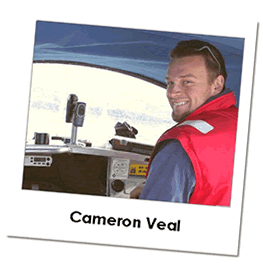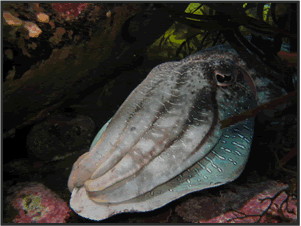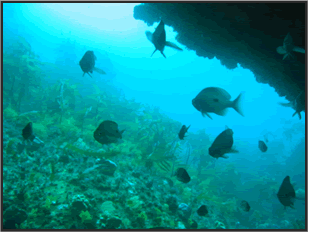
| Home > The Scientists > Cameron Veal | |||||||||||||||
During his first year at uni, Cam’s passion for marine science was sparked by a diving expedition. “I was running a night dive in the Tinderbox Marine Reserve, south of Hobart, and discovered a Spotted Handfish (Brachionichyths hirsutus),” Cam explains. “This species only occurs in southern Tasmania and is listed as endangered. I reported the sighting to the CSIRO and subsequently, through my diving experience, landed a job working with them as a casual diver on their 2002 Spotted Handfish survey. Cam’s experience on a real scientific program while an undergraduate student was a great bonus and helped with his decision to specialise in both zoology and geography & environmental studies. Having graduated from his science degree in 2004, Cam is now employed as a part-time Technical Officer at the Tasmanian Aquaculture and Fisheries Institute (TAFI) and at the University’s School of Zoology. At TAFI, he works in the Marine Environment section with researchers investigating Sea Grass distribution around Tasmania. His daily routine there revolves around boating operations, laboratory work and report writing. At the School of Zoology, Cam’s main tasks are related to coordinating the School’s aquatic field operations and scuba diving. He has to construct and monitor field sites at a number of locations and water depths around the State for research investigating Black Lip Abalone (Haliotis rubra) and the Black Spiny Sea Urchin (Centrostephanus rodgersii). As if two jobs aren’t enough, Cam is also continuing his own research this year a part-time Honours student in zoology. He is investigating ultraviolet (UV) light in shallow waters bodies in Tasmania and Queensland. The amount of UV light penetrating water bodies at depth has changed vastly over the last 200 years in response to anthropogenic-induced changes to the atmospheric ozone layer. “My study aims to quantify how much UV light penetrates the surface water in an attempt to understand and to model shallow water environments,” Cam says. He has also applied to go to Antarctica in 2006 to study UV light in the seasonal pack ice. “After that I would like to start a PhD in another marine-related project.”
For Cam, science is a dynamic and constantly evolving area. “There is always more to be discovered! New instruments are always being developed and built, meaning there’s an ever- increasing number of study pathways opening up for new scientists. For me, my jobs and my research take me to amazing places and I’m always enthused. I want to know more!” Find out more about Cam's work Key words: Spotted Handfish, Spiny Sea Urchin, Black Lip Abalone, UV light Useful Websites: For more information (including underwater footage of the Spotted Handfish) and great ideas for classroom activities, visit:
|
|||||||||||||||


